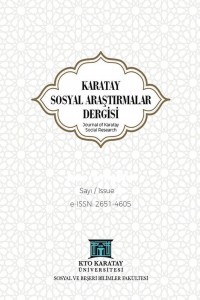GELİBOLULU MUSTAFA ÂLÎ’NİN MENÂKIB-I HÜNERVARÂN ADLI ESERİNDE OSMANLI’DA YAŞAMIŞ AZERBAYCANLI HATTAT, NAKKAŞ VE MÜCELLİTLER
Matbaanın alınmasından (1727) önce Osmanlı Devleti’nde kitabı yazmak için hattatlar, süslemek için nakkaşlar ve son olarak bunları kitap hâline getirmek için mücellitlere ihtiyaç vardı. Bu nedenle Akkoyunlu ve Safevi devletlerinin kuruluş ve gelişmesinde önemli payı olan Azerbaycan ve İran bölgesinden uğraştığı sanatta kendisini ispat etmiş birçok hattat, nakkaş ve mücellit planlı bir şekilde Osmanlı Devleti’ne getirilerek uygun müesseselere yerleştirilmiştir. Bunlar hakkında muhtelif Osmanlı kaynaklarında bilgi bulmak mümkündür. Bunlardan biri de Gelibolulu Mustafa Âlî’nin 1587’de Bağdat Hazinesi Defterdarı iken kaleme aldığı, hattat, nakkaş ve mücellitlerden bahseden Menâkıb-ı Hünervarân adlı eseridir. Kendisi de hattat olduğu için sanatı ve özellikle de dönemin sanatkârlarını iyi tanıyan Mustafa Âlî, bu eserinde çok sayıda Osmanlı Devleti’ne Azerbaycan sahasından gelerek yerleşmiş sanat erbabından övgülerle bahsetmektedir. Bunların arasında on bir hattat, altı nakkaş ve bir mücellit olduğu, bunların Osmanlı Devleti’nin değişik yerlerinde faaliyet gösterdikleri tespit edilmiştir. Osmanlı saraylarında hizmete alınan bu Azerbaycanlı sanatkârların katkısı sonucu Osmanlı kültür hayatında büyük ölçüde gelişme olmuş, böylece Azerbaycan’dan gelen hattalar zamanla Şeyh Hamdullah (ö. 1520) ekolünden başka Osmanlı Devleti’nde âdeta ayrı bir mektep tesis etmişlerdir. Nakkaşlar, XVI. yüzyıl Osmanlı minyatür sanatının gelişmesinde büyük rol oynamış, mücellitler ise güzel hatla süslü nakışları kitapla bütünleştirerek Şehnamecilik müessesesinin tesisini de hızlandırmıştır.
Anahtar Kelimeler:
Mustafa Âlî, Azerbaycan Sanatkârları, Mücellit, Hattat, Nakkaş
Azerbaijani Calligraphers, Miniaturists and Bookbinders Lived in the Ottoman Empire in Mustafa Âlî’s Book Menakib-i Hunervaran
Before the printing press (1727) there was a need for calligraphers to write the book, miniaturists to decorate the book and finally bookbinders to turn them into books in the Ottoman Empire. For this reason, famous calligraphers, miniaturists and bookbinders from Azerbaijan and Iran, which had an important role in the establishment and development of the Akkoyunlu and Safavid states, were brought to the Ottoman Empire in a planned manner and placed in appropriate establishments. It is possible to obtain information about these artists in various Ottoman sources. One of them is the book Menakıb-ı Hunervaran about those calligraphers, miniaturists and bookbinders which was written by Mustafa Âli Gelibolulu in 1587 when he was the Treasurer of Baghdad. Mustafa Âli, who knew the art and especially the craftsmen of the period well since he was a calligrapher himself praised many Azerbaijani artists who settled in the Ottoman Empire. It has been determined that there were ten calligraphers, six miniaturists and one bookbinder who were working in different places of the Ottoman Empire. Thanks to the contribution of these Azerbaijani artists working in the Ottoman palaces, the Ottoman cultural life was able to develop to a great extent. Thus, calligraphers from Azerbaijan eventually established their separate school in the Ottoman Empire apart from the school of Sheikh Hamdullah (d. 1520). Miniaturists played a great role in the development of the 16th century Ottoman miniature art, and bookbinders accelerated the establishment of Shahnameh institution by integrating beautiful calligraphy embroideries with the book.
Keywords:
Mustafa Âlî, Azerbaijani Artists, Bookbinder, Calligrapher, Miniaturist,
___
- Gelibolulu, Mustafa Âli. (1926). Menakıb-ı Hünerveran. İstanbul: Matbaa-ı Amire.
- Gelibolulu, Mustafa Âli. (1982). Hattatların ve Kitap Sanatçılarının Destanları (Menâkıb-ı Hünervarân ). Hazırlayan: Müjgan Cunbur, Ankara: Kültür ve Turizm Bakanlığı yayınları.
- Gelibolulu, Mustafa Âli. (1994). Künhü’l-Ahbar'ın Tezkire Kısmı. Hazırlayan: Mustafa İsen. Ankara: Özyurt Ofset & Tipo Matbaacılık.
- Genç, V. (2011). "Heşt Behişt Sarayı’ndan Topkapı Sarayı’na: Şah İsmail’in, Çaldıran Savaşı’ndan Sonra Alıkonulan Hazine ve Eşyaları", Toplumsal Tarih, S. 208, s. 24-36.
- Habib Efendi. (1306). Hatt ve Hattatan. İstanbul: Matbaa i Ebuz-ziya.
- Yayın Aralığı: Yılda 2 Sayı
- Başlangıç: 2018
- Yayıncı: KTO Karatay Üniversitesi
Sayıdaki Diğer Makaleler
BİR İHTİLALCİ OLARAK ALİ SUAVİ
BOTSA (GÜNEYDERE) ERKEN TARİHİ
OSMANLI SONRASI BALKAN DEVLETLERİNDE BAZI İSLAMİ GELİŞMELER VE DİN EĞİTİMİ
ÖRNEK BİLİM ADAMI/PROF. DR. NEJAT GÖYÜNÇ
OSMANLI SEVDALISI VE CUMHURİYET ÂŞIĞI BİR BİLİM ADAMI: PROF. DR. HASAN NEJAT GÖYÜNÇ
OSMANLI AKSARAY’INDA TEKKE VE ZAVİYELER (XVIII-XIX. YÜZYILLAR)
OSMANLI SON DÖNEMİNDE NARENCİYE ÜRETİM VE DIŞ TİCARETİ
İLMİN VE İNSANLIĞIN ZİRVESİNDE BİR İSİM: PROF. DR. NEJAT GÖYÜNÇ
